‘Nothingness’, migrants and de-bordering: effects of post-Soviet conflicts on a small Armenian town
DOI: 10.60650/EMPTINESS-VXXG-TZ03
Several months into the start of the Russia-Ukraine war, a ‘commune’ of émigrés and refugee artists from Russia, Ukraine, Belarus, and Iran began renovating an abandoned textile factory building (hereafter, Fabrika) in Ajidzor[1]Pseudonym of field site., a small town in a northern mountainous province of Armenia. This opportunity for the migrants to settle in Ajidzor was based on the condition of creating an artists’ residence inside Fabrika. But the premises required extensive repairs before it could host a creative space.
As I walked uphill on my first day in Ajidzor to meet the people who soon became my interlocutors, I marvelled at the magnificent Fabrika (Fig 1), its subtle classical form erected in pink tuff, the most common Armenian construction material. Upon entering, I thought of its vibrant life during state socialism.
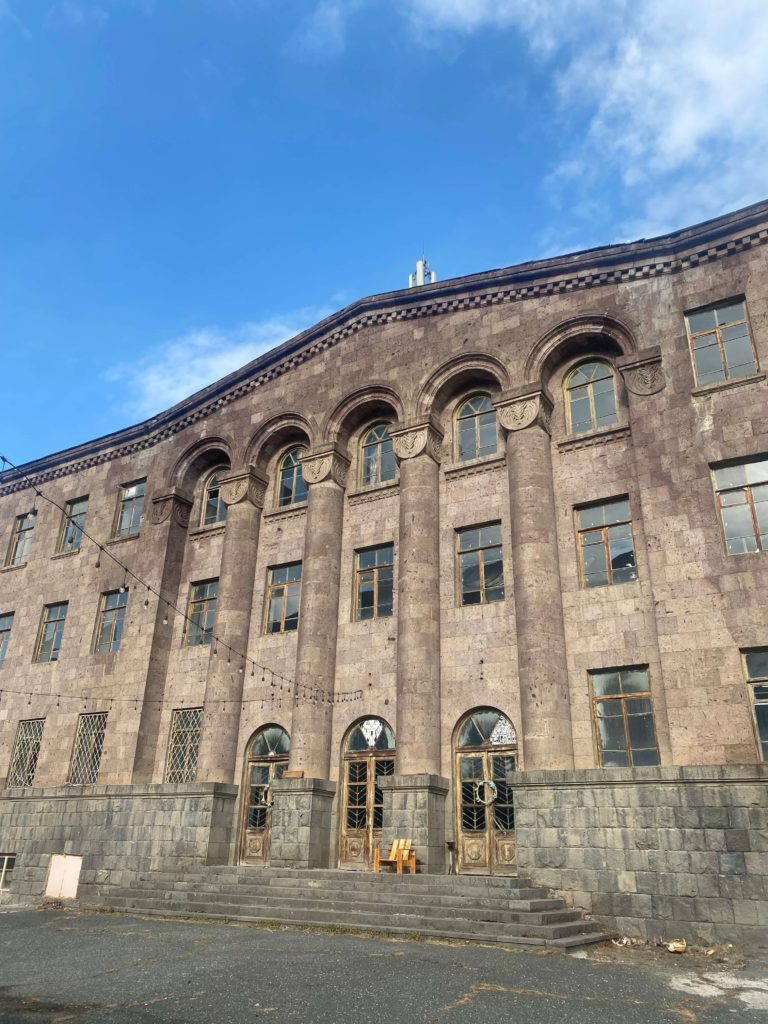
Constructed as a school in the late 1940s, Fabrika had been filled with kids running joyfully through the corridors. Later, it hosted a textile industry with dozens of workers from all over the Soviet Union. Now the building was sinking into obscurity, embodied by the gusts of wind moving through the empty space, by the smells of wet stone, soil and mould. Decay was also evident in the town itself – broken pavements, wild plots of land, dark windows in vacant apartments, derelict buildings, and rusty fences all signalled that life has gone elsewhere.
I imagine that for a long time, it was unthinkable anything new could emerge from the ruins of Soviet modernity in this backwater town. It was almost as unthinkable as a war between Russia and Ukraine. However, the unprecedented act of military aggression in February 2022 sparked a fast-paced reordering of the world, contributing to the ruination and emptying of some territories in the post-Soviet realm and, as it turns out, simultaneously bringing new life to others.
Argued by Martin Saxer and Ruben Andersson (2019: 1), instead of a globalized world smoothly connected by capital, information, and cultural flows, the world of today looks “more rugged and uneven than it has in a long time”. After the collapse of state socialism, countries of the former Soviet Union embarked on various paths with at times dissimilar outcomes and patterns. One similarity, however, is the increasing spatial polarization characteristic of uneven capitalist landscapes (Harvey 2006).
When I began fieldwork in Armenia, people in casual conversation would say about small towns that “there is nothing here” (aistegh vochinch chka [այստեղ ոչինչ չկա]). This is similar to other emic descriptors of emptiness found throughout the post-Soviet realm and beyond. Yet the ‘nothing here’ does not mean an absence of things, but rather a reconfiguration of relations between people, space, state, and capital after the collapse of state socialism (Dzenovska 2020). The seeming ‘nothing’ is actually a something, produced by the combination of ‘shock therapy’, liberalization, hectic privatization, and tensions of reterritorialization. Armenian ‘nothingness’ is largely the result of the ongoing territorial conflict with Azerbaijan in Nagorny Karabakh, which has become constitutive for shaping the contemporary Armenian state, its policies, as well as everyday life (Papazian 2008).
Ajidzor followed the path of many small towns in the post-Soviet space which ended up impoverished, devalued, and hollowed out after the fall of socialism. However, the collapse in the Armenian case seems to be one of the most abrupt and profound, due to the unprecedented country-wide energy crisis of 1992-95 caused by the Nagorno-Karabakh conflict. This period gained the name ‘dark years’ (Mut tariner [Մութ տարիներ]). Deprived of gas supplies[2]Starting in 1991, transit gas supply to Armenia was blocked by Azerbaijan. Turkey completely closed its border and airspace, and the gas pipeline running through war-ravaged Georgia was repeatedly … Continue reading, daily blackouts in Armenia began in January 1992. By November 1992, it was officially announced that electricity would be supplied to homes for only one hour a day, but even this hour was not guaranteed. Telephones and radios did not work, almost all public transport was stopped, and most schools and hospitals were closed. Only a few key factories were allowed to stay open, leaving an estimated two-thirds or more of the population jobless.
In mid-1995, electricity supply was restored, but the country never fully recovered from those events. According to various estimates, around half a million people emigrated, leaving behind vacant housing. Soviet-made infrastructures crumbled and numerous industrial enterprises became grounds for salvage-value accumulation from the reuse and recycle of Soviet modernity’s remnants (Khatchadourian 2022). These processes materially reflect the dynamic (un)making of the Soviet state’s power and the lives it had sustained (Humphrey 2002).
Since the early 1990s, the Ajidzor textile factory (along with other enterprises in the town) stayed mostly idle, with only one small space used to sell fruit and vegetables. In 2018, Fabrika was bought by a diasporan Armenian. He had some ideas for the factory, including turning it into a site for some sort of creative business activity, namely an artists’ residence. However, nothing was done with the idea until ‘something happened’ in February 2022. A friend of the owner’s began working with and arranging assistance for creatives escaping to Armenia, and a collaboration began. The project soon gained the name Abastan[3]Western Armenian pronunciation.[Ապաստան] – which translates as ‘shelter’.
The war and repressions became the catalyst for an intensive inflow of artists and other creatives to Ajidzor, from early June 2022 onwards. Unable to work or express themselves freely, Russians and Belarusians (as well as Iranians) were driven by fear of potential repressions as well as actual political terror. Ukrainians sought refuge from the full-scale offensive war in their homeland. Upon arrival in Ajidzor, what they encountered was not a ready-made residence but a dilapidated vacant factory with a leaking roof (Figs 2a and 2b). Fabrika‘s glorious past was long gone:
…a massive building filled with garbage and remnants of [the] factory’s former industrial activities. Standing beside it, I saw a small number of people of different ages and backgrounds. Yet, they were all united by the fear of war and state terror, unwillingness to put up with it. I saw people who fled and were given shelter. But to make a life here, of course, there was a huge amount of work… (Vadim, a 38-year-old interlocutor)[4]Data from participant observations and interviews conducted in Aug, Nov and Dec 2022, and Jan 2023. All names for interlocutors are pseudonyms.
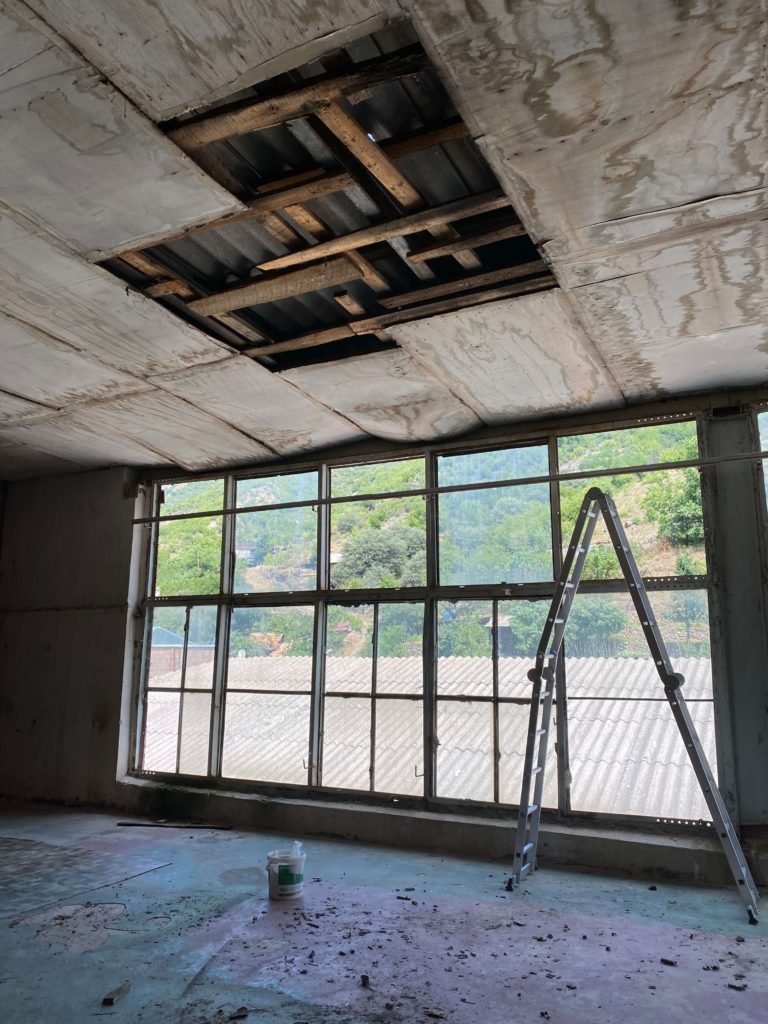
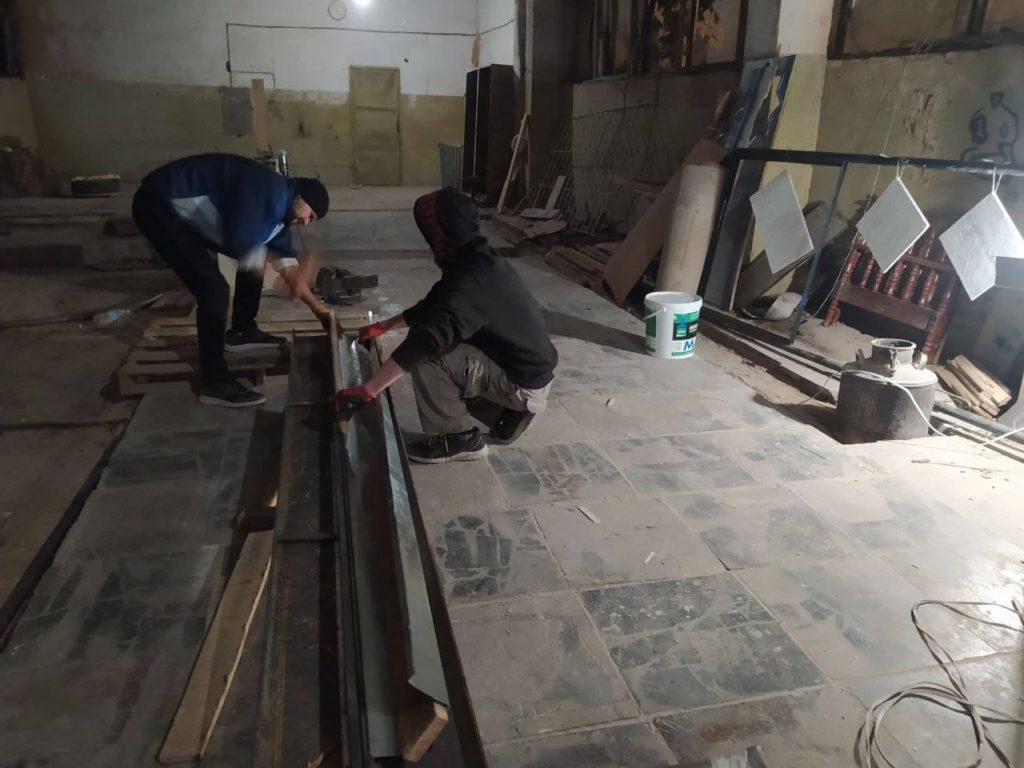
Working side-by-side – crowdfunding, DIY restoration of the building, establishing a common living space – and experiencing co-living (see Figs 2a and 2b, Figs 3a and 3b, Fig 4) drew together people of different nationalities and previous life experiences:
…At first, I met these interesting and sweet people who were doing something out of pure enthusiasm. And I wanted to contribute somehow – tear off old plaster, glue, paint. When you are scraping pigeon poop off the walls with someone or attempt to cover the roof with garbage bags and film, so rain doesn’t flow over your head, this inevitably unites and builds sort of kin ties. This dissolves borders… (Inna, a 31-year-old interlocutor)
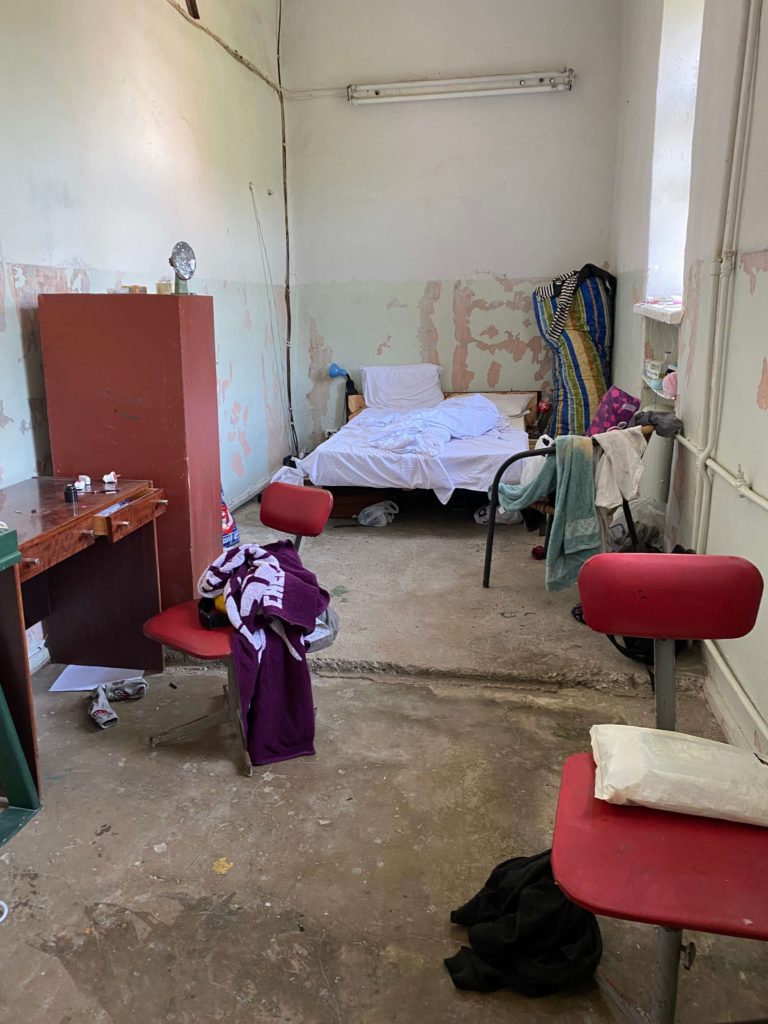
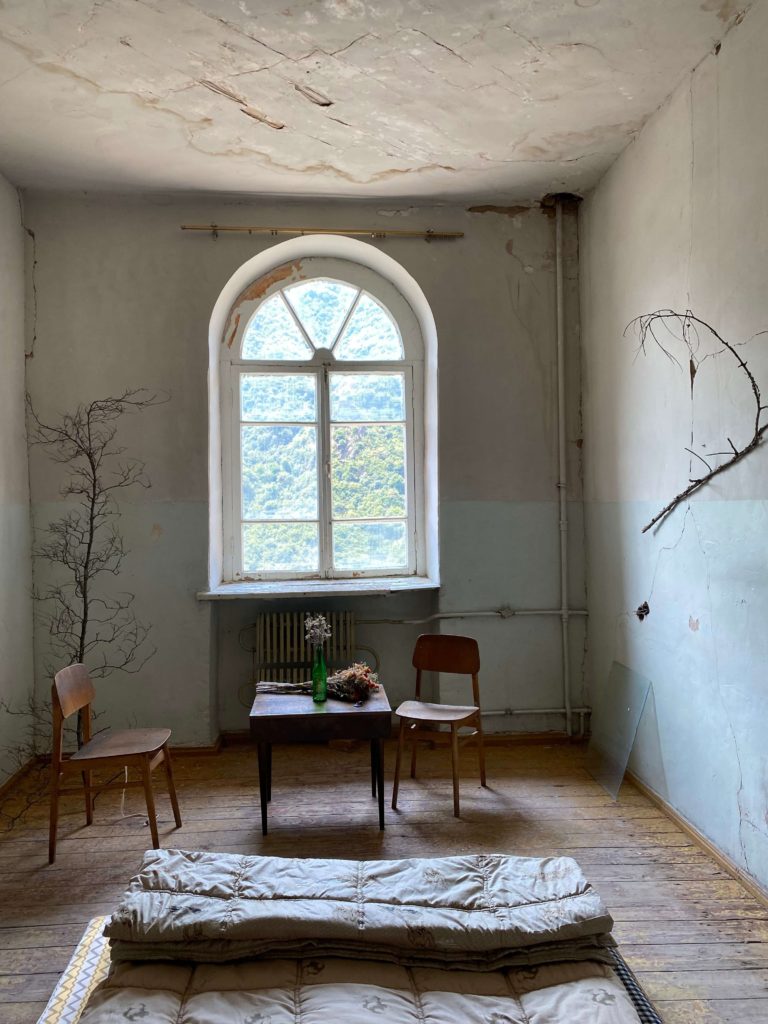
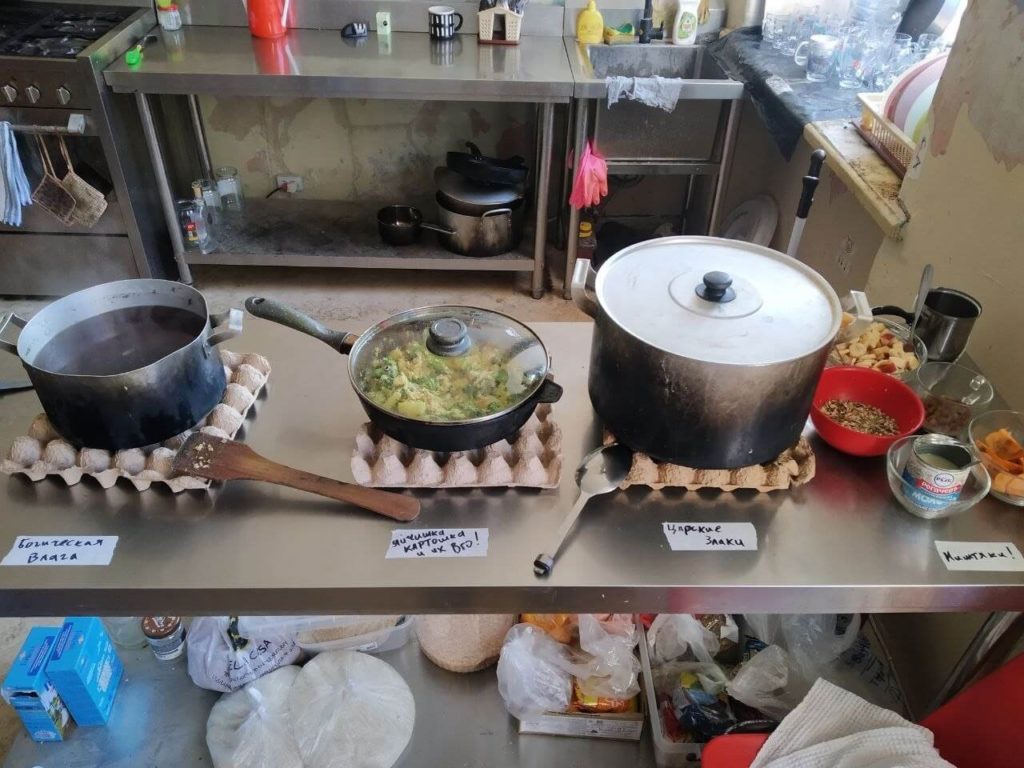
The micro-level commonality and de-bordering I witnessed seemed to be underpinned by a shared history and the desire to escape state-induced violence. But it was crystallized through the shared effort to repair Fabrika. We should thus be careful not to overly romanticize solidarity and avoid rooting it in ‘grand narratives’ about a loosely defined ‘common humanity’ (Ambrosini 2022). Rather, such solidarity involves some degree of both ‘egoistic altruism’ (Chouliaraki 2013) and fulfilment of ‘profound neediness’ – a desire to create something greater than oneself (Malkki 2015). Several interlocutors highlighted the therapeutic effects of feeling needed, a sense of satisfaction in contributing to something that will “remain and remind of us” (Anna, 34-year-old interlocutor).
Following the upgrading of Fabrika, new meanings and activities also emerged for other abandoned buildings, such as the opening of a café in a former shop, along with the repopulation and renovation of vacant apartments by Abastan members who chose to winter in Ajidzor when Fabrika was closed in mid-November 2022 due to the leaking roof (Fig 5a and b).
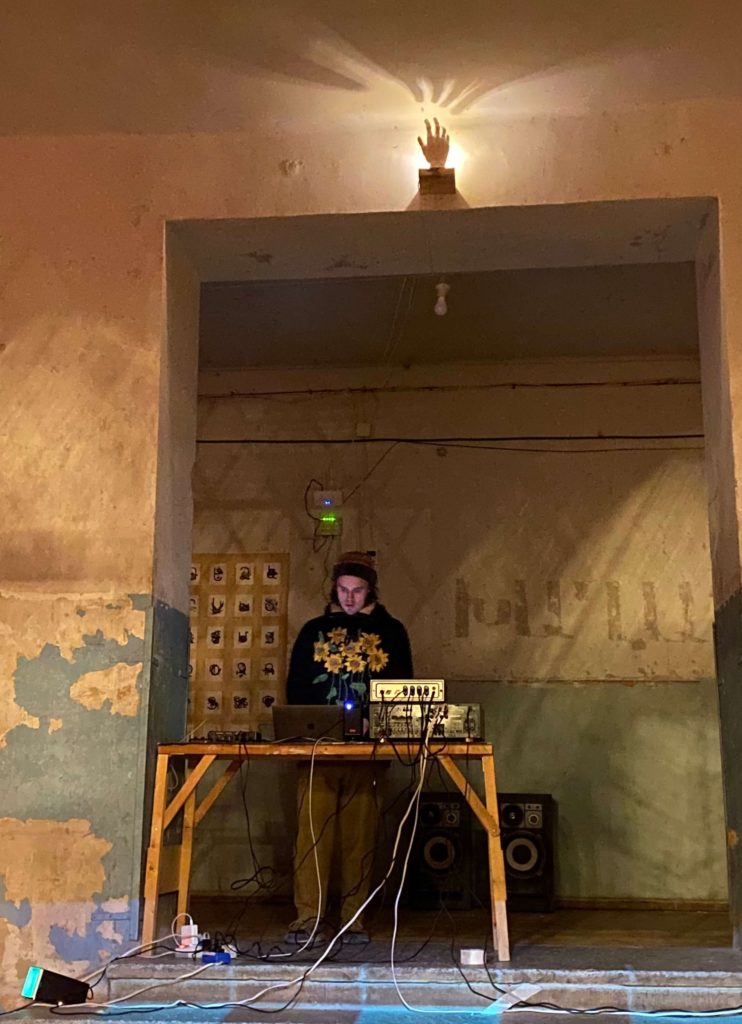
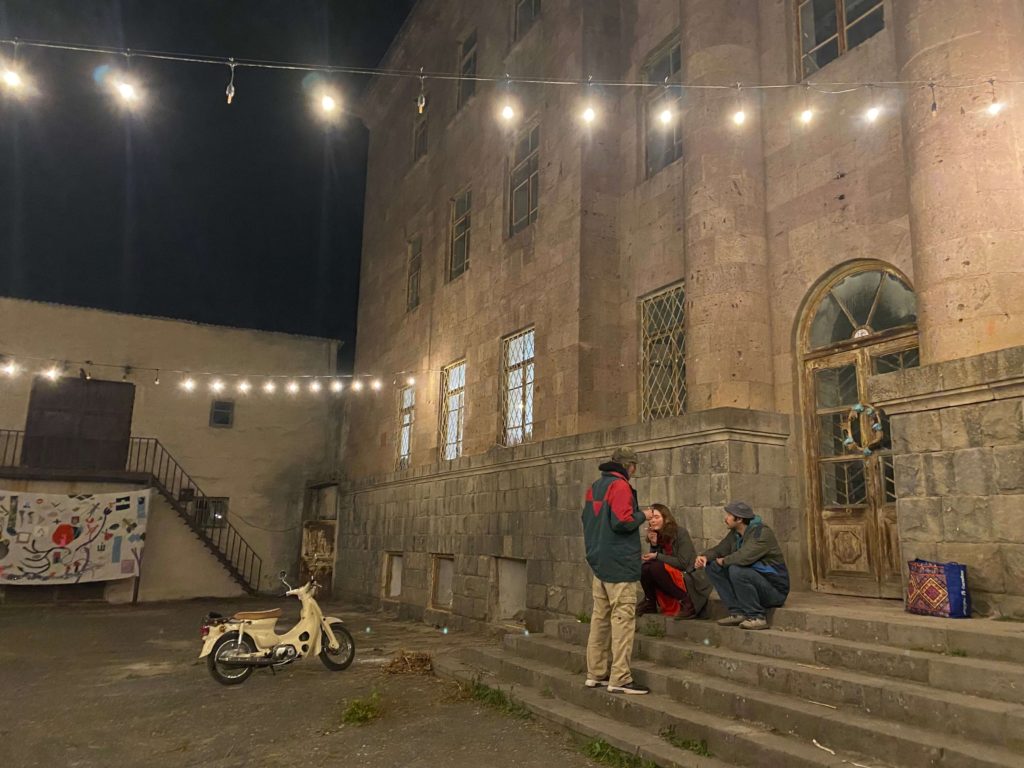
These activities fostered closer dialogue between the predominantly Slavic-speaking Abastan and the Armenian residents of Ajidzor. With a shared history of fleeing violence and constantly living in fear of a full-scale war with Azerbaijan, Armenians expressed a sympathetic and welcoming attitude towards not only Ukrainians but also Russian and Belarusians. This defies the images of separation portrayed by the media in the Global North, where Russians and Belarusians are seen as unwelcome and untrustworthy. Borders that divide nations at the macro level appear to be less definitive at the micro level.
In January 2023, I found Abastan and the residents of Ajidzor engaged in ongoing rapprochement to endure winter’s hardships together. The inheritance of the ‘dark years’ – e.g. infrastructural disruptions such as the lack of central heating in houses and apartments, recurrent blackouts, water outages, and pipe bursts – is faced by all Ajidzor residents and requires some collaboration for survival:
…Eventually, it became clear that it is possible and even necessary not only to help each other [within Abastan], but also to help [Ajidzor residents]. At one point, Anton [a neighbour] tells me: “I’m running over to Grandma Arpi, are you coming with me?”. I asked what had happened. “A pipe in her bathroom burst.” So we ran to Grandma Arpi to engaged in a two-day fight with an absolutely rusted water pipe. But we did not win until our team was joined by several Armenians of different ages and professions. On the evening of the second day there were about seven of us in that cramped bathroom… (Yuren, a 50-year-old interlocutor)
War creates conditions for abrupt cuts in ties; but such extreme and revelatory circumstances also prompt individuals to find solidarity with one another (Josiassen, Kock & Assaf 2022). Shared memories and fears underlie solidarities in Ajidzor, reinforced by a common and embodied experience of overcoming everyday hardships. Abastan is literally building a new future for Ajidzor, with the upgrades to Fabrika as its most tangible manifestation. My interlocutors describe this experience as something between a hippie commune and a summer camp. They implied an objection against borders and bordering, whether between nationalities, genders, sexualities, or age groups. At its peak, in summer 2022, over 60 people co-lived at Fabrika and the local hostel – men, women and non-binary people aged between 18 and 50. In winter 2023, around 20 of them remain in Ajidzor while Abastan lays low before the re-opening of Fabrika in the spring.
“I felt home, I felt welcomed and accepted”. This is a common narrative expressed about Abastan and Ajidzor in general, irrespective of whether the people I interviewed were visiting for several summer weeks or staying to winter there. Solidarity has created a community out of desperate and dispersed people who “felt emptied inside and fled from war into emptiness” (Aleksander, a 25-year-old interlocutor). Local people and migrants’ collective efforts to restore Fabrika and pursue life in Ajidzor appear to be gradually – materially and metaphorically – filling their inner ’emptiness’, as well as the ‘nothingness’ left in this small Armenian town by the postsocialist reordering, the ‘dark years’, and the ongoing conflict with Azerbaijan.
This is an Open Access article, distributed under the terms of the CC-BY (Creative Commons Attribution 4.0 International) licence, which permits unrestricted re-use, distribution, and reproduction in any medium, provided the original work is properly cited.
Footnotes
| ↑1 | Pseudonym of field site. |
|---|---|
| ↑2 | Starting in 1991, transit gas supply to Armenia was blocked by Azerbaijan. Turkey completely closed its border and airspace, and the gas pipeline running through war-ravaged Georgia was repeatedly blown up. The only remaining transport link – the road to the Georgian port of Poti – could not provide Armenia with all the necessary resources, especially energy resources. |
| ↑3 | Western Armenian pronunciation. |
| ↑4 | Data from participant observations and interviews conducted in Aug, Nov and Dec 2022, and Jan 2023. All names for interlocutors are pseudonyms. |